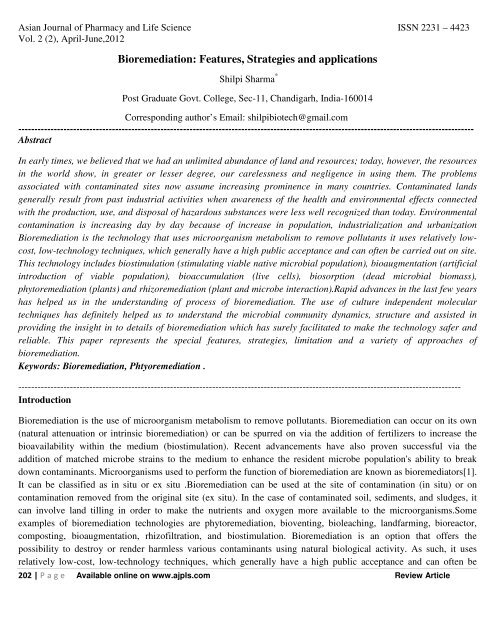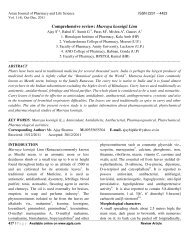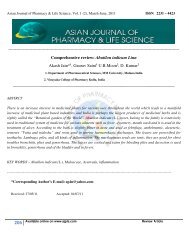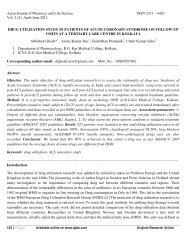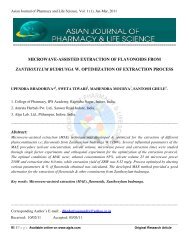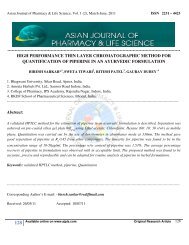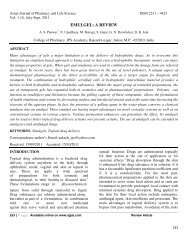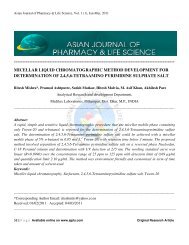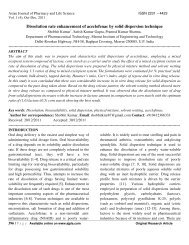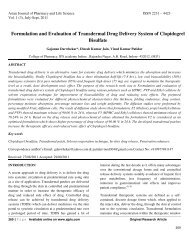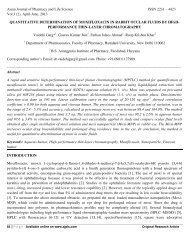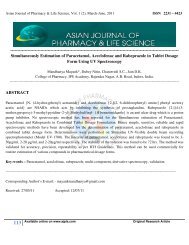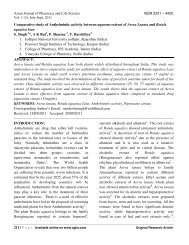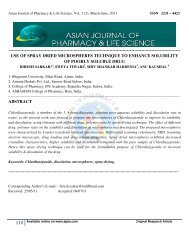Bioremediation - Asian Journal of Pharmacy and Life Science
Bioremediation - Asian Journal of Pharmacy and Life Science
Bioremediation - Asian Journal of Pharmacy and Life Science
You also want an ePaper? Increase the reach of your titles
YUMPU automatically turns print PDFs into web optimized ePapers that Google loves.
<strong>Asian</strong> <strong>Journal</strong> <strong>of</strong> <strong>Pharmacy</strong> <strong>and</strong> <strong>Life</strong> <strong>Science</strong> ISSN 2231 – 4423Vol. 2 (2), April-June,2012<strong>Bioremediation</strong>: Features, Strategies <strong>and</strong> applicationsShilpi Sharma *Post Graduate Govt. College, Sec-11, Ch<strong>and</strong>igarh, India-160014Corresponding author’s Email: shilpibiotech@gmail.com---------------------------------------------------------------------------------------------------------------------------------------------AbstractIn early times, we believed that we had an unlimited abundance <strong>of</strong> l<strong>and</strong> <strong>and</strong> resources; today, however, the resourcesin the world show, in greater or lesser degree, our carelessness <strong>and</strong> negligence in using them. The problemsassociated with contaminated sites now assume increasing prominence in many countries. Contaminated l<strong>and</strong>sgenerally result from past industrial activities when awareness <strong>of</strong> the health <strong>and</strong> environmental effects connectedwith the production, use, <strong>and</strong> disposal <strong>of</strong> hazardous substances were less well recognized than today. Environmentalcontamination is increasing day by day because <strong>of</strong> increase in population, industrialization <strong>and</strong> urbanization<strong>Bioremediation</strong> is the technology that uses microorganism metabolism to remove pollutants it uses relatively lowcost,low-technology techniques, which generally have a high public acceptance <strong>and</strong> can <strong>of</strong>ten be carried out on site.This technology includes biostimulation (stimulating viable native microbial population), bioaugmentation (artificialintroduction <strong>of</strong> viable population), bioaccumulation (live cells), biosorption (dead microbial biomass),phytoremediation (plants) <strong>and</strong> rhizoremediation (plant <strong>and</strong> microbe interaction).Rapid advances in the last few yearshas helped us in the underst<strong>and</strong>ing <strong>of</strong> process <strong>of</strong> bioremediation. The use <strong>of</strong> culture independent moleculartechniques has definitely helped us to underst<strong>and</strong> the microbial community dynamics, structure <strong>and</strong> assisted inproviding the insight in to details <strong>of</strong> bioremediation which has surely facilitated to make the technology safer <strong>and</strong>reliable. This paper represents the special features, strategies, limitation <strong>and</strong> a variety <strong>of</strong> approaches <strong>of</strong>bioremediation.Keywords: <strong>Bioremediation</strong>, Phtyoremediation .-----------------------------------------------------------------------------------------------------------------------------------------Introduction<strong>Bioremediation</strong> is the use <strong>of</strong> microorganism metabolism to remove pollutants. <strong>Bioremediation</strong> can occur on its own(natural attenuation or intrinsic bioremediation) or can be spurred on via the addition <strong>of</strong> fertilizers to increase thebioavailability within the medium (biostimulation). Recent advancements have also proven successful via theaddition <strong>of</strong> matched microbe strains to the medium to enhance the resident microbe population's ability to breakdown contaminants. Microorganisms used to perform the function <strong>of</strong> bioremediation are known as bioremediators[1].It can be classified as in situ or ex situ .<strong>Bioremediation</strong> can be used at the site <strong>of</strong> contamination (in situ) or oncontamination removed from the original site (ex situ). In the case <strong>of</strong> contaminated soil, sediments, <strong>and</strong> sludges, itcan involve l<strong>and</strong> tilling in order to make the nutrients <strong>and</strong> oxygen more available to the microorganisms.Someexamples <strong>of</strong> bioremediation technologies are phytoremediation, bioventing, bioleaching, l<strong>and</strong>farming, bioreactor,composting, bioaugmentation, rhiz<strong>of</strong>iltration, <strong>and</strong> biostimulation. <strong>Bioremediation</strong> is an option that <strong>of</strong>fers thepossibility to destroy or render harmless various contaminants using natural biological activity. As such, it usesrelatively low-cost, low-technology techniques, which generally have a high public acceptance <strong>and</strong> can <strong>of</strong>ten be202 | P a g e Available online on www.ajpls.com Review Article
<strong>Asian</strong> <strong>Journal</strong> <strong>of</strong> <strong>Pharmacy</strong> <strong>and</strong> <strong>Life</strong> <strong>Science</strong> ISSN 2231 – 4423Vol. 2 (2), April-June,2012carried out on site. It will not always be suitable, however, as the range <strong>of</strong> contaminants on which it is effective islimited, the time scales involved are relatively long, <strong>and</strong> the residual contaminant levels achievable may not alwaysbe appropriate. Although the methodologies employed are not technically complex, considerable experience <strong>and</strong>expertise may be required to design <strong>and</strong> implement a successful bioremediation program, due to the need tothoroughly assess a site for suitability <strong>and</strong> to optimize conditions to achieve a satisfactory result. The conventionaltechniques used for remediation have been to dig up contaminated soil <strong>and</strong> remove it to a l<strong>and</strong>fill, or to cap <strong>and</strong>contain the contaminated areas <strong>of</strong> a site. The methods have some drawbacks. The first method simply moves thecontamination elsewhere <strong>and</strong> may create significant risks in the excavation, h<strong>and</strong>ling, <strong>and</strong> transport <strong>of</strong> hazardousmaterial. Additionally, it is very difficult <strong>and</strong> increasingly expensive to find new l<strong>and</strong>fill sites for the final disposal <strong>of</strong>the material. The cap <strong>and</strong> contain method is only an interim solution since the contamination remains on site,requiring monitoring <strong>and</strong> maintenance <strong>of</strong> the isolation barriers long into the future, with all the associated costs <strong>and</strong>potential liability. A better approach than these traditional methods is to completely destroy the pollutants if possible,or at least to transform them to innocuous substances. Some technologies that have been used are high-temperatureincineration <strong>and</strong> various types <strong>of</strong> chemical decomposition (e.g., base-catalyzed dechlorination, UV oxidation). Theycan be very effective at reducing levels <strong>of</strong> a range <strong>of</strong> contaminants, but have several drawbacks, principally theirtechnological complexity, the cost for small-scale application, <strong>and</strong> the lack <strong>of</strong> public acceptance, especially forincineration that may increase the exposure to contaminants for both the workers at the site <strong>and</strong> nearby residents.Principle <strong>of</strong> <strong>Bioremediation</strong>:-<strong>Bioremediation</strong> is defined as the process whereby organic wastes are biologically degraded under controlledconditions to an innocuous state, or to levels below concentration limits established by regulatory authorities [2] Forbioremediation to be effective, microorganisms must enzymatically attack the pollutants <strong>and</strong> convert them toharmless products. As bioremediation can be effective only where environmental conditions permit microbial growth<strong>and</strong> activity, its application <strong>of</strong>ten involves the manipulation <strong>of</strong> environmental parameters to allow microbial growth<strong>and</strong> degradation to proceed at a faster rate. <strong>Bioremediation</strong> techniques are typically more economical than traditionalmethods such as incineration, <strong>and</strong> some pollutants can be treated on site, thus reducing exposure risks for clean-uppersonnel, or potentially wider exposure as a result <strong>of</strong> transportation accidents. Since bioremediation is based onnatural attenuation the public considers it more acceptable than other technologies. Most bioremediation systems arerun under aerobic conditions, but running a system under anaerobic conditions may permit microbial organisms todegrade otherwise recalcitrant molecules [3]Factors <strong>of</strong> <strong>Bioremediation</strong>:-The control <strong>and</strong> optimization <strong>of</strong> bioremediation processes is a complex system <strong>of</strong> many factors. These factorsinclude: the existence <strong>of</strong> a microbial population capable <strong>of</strong> degrading the pollutants; the availability <strong>of</strong> contaminantsto the microbial population; the environment factors (type <strong>of</strong> soil, temperature, pH , the presence <strong>of</strong> oxygen or otherelectron acceptors, <strong>and</strong> nutrients).203 | P a g e Available online on www.ajpls.com Review Article
<strong>Asian</strong> <strong>Journal</strong> <strong>of</strong> <strong>Pharmacy</strong> <strong>and</strong> <strong>Life</strong> <strong>Science</strong> ISSN 2231 – 4423Vol. 2 (2), April-June,2012Table 1 Showing factors <strong>of</strong> bioremediationFactorsMicroorganismsNatural Biological processes <strong>of</strong> microorganismEnvironmental FactorsNutrientsSoil MoistureType <strong>of</strong> soilCondition requiredAerobic or AnaerobicCatabolism <strong>and</strong> AnabolismTemperature, pH ,Oxygen content, Electron acceptor/donorCarbon ,Nitrogen ,Oxygen etc25-28% <strong>of</strong> water holding capacityLow clay or silt contentMicroorganisms can be isolated from almost any environmental conditions. Microbes will adapt <strong>and</strong> grow at subzerotemperatures, as well as extreme heat, desert conditions, in water, with an excess <strong>of</strong> oxygen, <strong>and</strong> in anaerobicconditions, with the presence <strong>of</strong> hazardous compounds or on any waste stream. The main requirements are an energysource <strong>and</strong> a carbon source. <strong>of</strong> microbes <strong>and</strong> other biological systems, these can be used to degrade or remediateenvironmental hazards.We can subdivide these microorganisms into the following groups:Aerobic. In the presence <strong>of</strong> oxygen. Examples <strong>of</strong> aerobic bacteria recognized for their degradative abilities arePseudomonas, Alcaligenes, Sphingomonas, Rhodococcus, <strong>and</strong> Mycobacterium. These microbes have <strong>of</strong>ten beenreported to degrade pesticides <strong>and</strong> hydrocarbons, both alkanes <strong>and</strong> compounds. Many <strong>of</strong> these bacteria use thecontaminant as the sole source <strong>of</strong> carbon <strong>and</strong> energy.Anaerobic. In the absence <strong>of</strong> oxygen. Anaerobic bacteria are not as frequently used as aerobic bacteria. There is anincreasing interest in anaerobic bacteria used for bioremediation <strong>of</strong> polychlorinated biphenyls (PCBs) in riversediments, dechlorination <strong>of</strong> the solvent trichloroethylene (TCE), <strong>and</strong> chlor<strong>of</strong>orm.Ligninolytic fungi. Fungi such as the white rot fungus Phanaerochaete chrysosporium have the ability to degrade anextremely diverse range <strong>of</strong> persistent or toxic environmental pollutants. Common substrates used include straw, sawdust, or corn cobs.Methylotrophs. Aerobic bacteria that grow utilizing methane for carbon <strong>and</strong> energy. The initial enzyme in thepathway for aerobic degradation, methane monooxygenase, has a broad substrate range <strong>and</strong> is active against a widerange <strong>of</strong> compounds, including the chlorinated aliphatics trichloroethylene <strong>and</strong> 1,2-dichloroethane.Enironmental factorsNutrientsCarbon is the most basic element <strong>of</strong> living forms <strong>and</strong> is needed in greater quantities than other elements. In additionto hydrogen, oxygen, <strong>and</strong> nitrogen it constitutes about 95% <strong>of</strong> the weight The type <strong>of</strong> bioremediation depends on theconcentration <strong>of</strong> soil contaminants Phosphorous <strong>and</strong> sulfur contribute with 70% <strong>of</strong> the remainders. The nutritionalrequirement <strong>of</strong> carbon to nitrogen ratio is 10:1, <strong>and</strong> carbon to phosphorous is 30:1.204 | P a g e Available online on www.ajpls.com Review Article
<strong>Asian</strong> <strong>Journal</strong> <strong>of</strong> <strong>Pharmacy</strong> <strong>and</strong> <strong>Life</strong> <strong>Science</strong> ISSN 2231 – 4423Vol. 2 (2), April-June,2012Table 2 Showing environmental conditions [4]Environmental Factor Optimum conditions Condition required for microbialActivityAvailable soil moisture 25-85% water holding capacity 25-28% <strong>of</strong> water holding capacityOxygen>0.2 mg/L DO, >10% air-filled pore space foraerobic degradationAerobic, minimum air-filled porespace <strong>of</strong> 10%Redox potential Eh > 50 mill voltsNutrients C:N:P= 120:10:1 molar ratio N <strong>and</strong> P for microbial growthpH 6.5-8.0 5.5 to 8.5Temperature 20-30 ºC 15-45ºCContaminants Hydrocarbon 5-10% <strong>of</strong> dry weight <strong>of</strong> soil Not too toxicHeavy metals 700ppm Total content 2000ppmSoil1. High concentrations <strong>of</strong> contaminants (roughly 5% or more): The soil is agitated in a purifying water solutioncontaining interface active agent, then separated from the oils. After that, bioremediation is started to efficiently cleanthe soil. At the experimental stage, bioremediation alone has been able to turn contaminated soil into soil suited forl<strong>and</strong>scaping, <strong>and</strong> work is continuing to make this process even more efficient <strong>and</strong> effective.2. Low concentrations <strong>of</strong> contaminants : Soils that have low concentrations <strong>of</strong> contaminants can be treated usingbioremediation alone. It takes about 6 months to a year to purify soil containing two percent heavy oils, but at aconcentration <strong>of</strong> 0.8 percent, the job can be done in only about one to two months. This environmentally-friendlymethod makes it possible to recycle <strong>and</strong> reuse soil without much effort.<strong>Bioremediation</strong> strategies:-In-Situ <strong>Bioremediation</strong>:In situ bioremediation is the application <strong>of</strong> biological treatment to the cleanup <strong>of</strong> hazardous chemicals present in thesubsurface. The optimization <strong>and</strong> control <strong>of</strong> microbial transformations <strong>of</strong> organic contaminants require the integration <strong>of</strong>many scientific <strong>and</strong> engineering disciplines.Biosparging.Biosparging involves the injection <strong>of</strong> air under pressure below the water table to increase groundwater oxygenconcentrations <strong>and</strong> enhance the rate <strong>of</strong> biological degradation <strong>of</strong> contaminants by naturally occurring bacteria.Biosparging increases the mixing in the saturated zone <strong>and</strong> thereby increases the contact between soil <strong>and</strong>groundwater. The ease <strong>and</strong> low cost <strong>of</strong> installing small-diameter air injection points allows considerable flexibility inthe design <strong>and</strong> construction <strong>of</strong> the system.205 | P a g e Available online on www.ajpls.com Review Article
<strong>Asian</strong> <strong>Journal</strong> <strong>of</strong> <strong>Pharmacy</strong> <strong>and</strong> <strong>Life</strong> <strong>Science</strong> ISSN 2231 – 4423Vol. 2 (2), April-June,2012BioventingBioventing is a promising new technology that stimulates the natural in-situ biodegradation <strong>of</strong> any aerobicallydegradablecompounds in NAPL within the soil by providing oxygen to existing soil microorganisms. In contrast tosoil-vapor extraction (SVE), bioventing uses low air-flow rates to provide only enough oxygen to sustain microbialactivity. Oxygen is most commonly supplied through direct air injection into residual contamination in soil by means<strong>of</strong> wells. Adsorbed fuel residuals are biodegraded, <strong>and</strong> volatile compounds also are biodegraded as vapors moveslowly through biologically active soil.[5]BioaugmentationBioaugmentation is the introduction <strong>of</strong> a group <strong>of</strong> natural microbial strains or a genetically engineered variant to treatcontaminated soil or water. It is commonly used in municipal wastewater treatment to restart activated sludgebioreactors. Most cultures available contain a research based consortium <strong>of</strong> Microbial cultures, containing allnecessary microorganisms At sites where soil <strong>and</strong> groundwater are contaminated with chlorinated ethenes, such astetrachloroethylene <strong>and</strong> trichloroethylene, bioaugmentation is used to ensure that the in situ microorganisms cancompletely degrade these contaminants to ethylene <strong>and</strong> chloride, which are non-toxic[6] Monitoring <strong>of</strong> this system isdifficultBiopilingBiopile treatment is a full-scale technology in which excavated soils are mixed with soil amendments, placed on atreatment area, <strong>and</strong> bioremediated using forced aeration. The contaminants are reduced to carbon dioxide <strong>and</strong> water.The basic biopile system includes a treatment bed, an aeration system, an irrigation/nutrient system <strong>and</strong> a leach atecollection system. Moisture, heat, nutrients, oxygen, <strong>and</strong> pH are controlled to enhance biodegradation. Theirrigation/nutrient system is buried under the soil to pass air <strong>and</strong> nutrients either by vacuum or positive pressure. Soilpiles can be up to 20 feet high <strong>and</strong> may be covered with plastic to control run<strong>of</strong>f, evaporation <strong>and</strong> volatilization, <strong>and</strong>to promote solar heating. If volatile organic compounds (VOCs) in the soil volatilize into the air stream, the airleaving the soil may be treated to remove or destroy the VOCs before they are discharged into the atmosphere.Treatment time is typically 3 to 6 months [7]Ex-Situ <strong>Bioremediation</strong>Composting is a process by which organic wastes are degraded by microorganisms, typically at elevatedtemperatures.Typical compost temperatures are in the range <strong>of</strong> 55° to 65° C. The increased temperatures result fromheat produced by microorganisms during the degradation <strong>of</strong> the organic material in the waste. Windrow compostinghas been demonstrated using the following basic steps. First, contaminated soils are excavated <strong>and</strong> screened toremove large rocks <strong>and</strong> debris [8,9]BioreactorsSlurry reactors or aqueous reactors are used for ex situ treatment <strong>of</strong> contaminated soil <strong>and</strong> water pumped up from acontaminated plume. <strong>Bioremediation</strong> in reactors involves the processing <strong>of</strong> contaminated solid material (soil,sediment, sludge) or water through an engineered containment system. A slurry bioreactor may be defined as acontainment vessel <strong>and</strong> apparatus used to create a three-phase (solid, liquid, <strong>and</strong> gas) mixing condition to increase thebioremediation rate <strong>of</strong> soil bound <strong>and</strong> water-soluble pollutants as a water slurry <strong>of</strong> the contaminated soil <strong>and</strong> biomass206 | P a g e Available online on www.ajpls.com Review Article
<strong>Asian</strong> <strong>Journal</strong> <strong>of</strong> <strong>Pharmacy</strong> <strong>and</strong> <strong>Life</strong> <strong>Science</strong> ISSN 2231 – 4423Vol. 2 (2), April-June,2012(usually indigenous microorganisms) capable <strong>of</strong> degrading target contaminants. In general, the rate <strong>and</strong> extent <strong>of</strong>biodegradation are greater in a bioreactor system than in situ or in solid-phase systems because the containedenvironment is more manageable <strong>and</strong> hence more controllable <strong>and</strong> predictable. Despite the advantages <strong>of</strong> reactorsystems, there are some disadvantages. The contaminated soil requires pre treatment (e.g., excavation) oralternatively the contaminant can be stripped from the soil via soil washingor physical extraction (e.g., vacuumextraction) before being placed in a bioreactor.Table 3. Developmental methods applied in bioremediation [10,11]Technique Examples Benefits Applications ReferencesIn Situ BiospargingMost efficient[12,6,1Non Invasive3]BioventingBioaugmentationEx situ L<strong>and</strong> farming (Solid-phasetreatment system)BioreactorsPrecipitationor FlocculationMicr<strong>of</strong>iltrationComposting(Anaerobic,converts solidorganic wastes into humus-likematerial)BiopilesSlurry reactorsAqueous reactorsNon-directed physico-chemicalcomplex -ation reactionbetween dissolved contamin -ants <strong>and</strong> charged cellularcomponents (deadBiomass)Micr<strong>of</strong>iltration membranes areused at a constant pressureElectrodialysis Uses cation <strong>and</strong> anionexchange membrane pairsRelative passiveNaturally attenuated process, treatsoil <strong>and</strong> waterCost efficient ,Simple,Inexpensive ,self-heatingLow cost Rapid reactionrate, Inexpensive, self heatingCan be done on siteBiodegradative abilities <strong>of</strong>indigenous microorganisms Presence<strong>of</strong> metals <strong>and</strong> inorganic compoundsEnvironmental parametersBiodegradability <strong>of</strong> pollutantsChemical solubility GeologicalfactorsDistribution <strong>of</strong> pollutantsSurface application, aerobic process,application <strong>of</strong> organic materials tonatural soils followed by irrigation<strong>and</strong> tillingTo make plants healthier goodalternative to l<strong>and</strong> filling orincinerating practical <strong>and</strong> convenient.Surface application, agricultural tomunicipal waste207 | P a g e Available online on www.ajpls.com Review Article[8,9]Rapid degradation kinetic Bioaugmentat Toxicity <strong>of</strong> [14]Optimized environmental amendmentsparametersEnhances mass transferToxic concentrations <strong>of</strong> contaminantsEffective use <strong>of</strong> inoculants<strong>and</strong> surfactantCost-effective Removal <strong>of</strong> heavy Metals [15]Remove dissolved solids rapidlyWithst<strong>and</strong> high temperature <strong>and</strong>can be reusedWaste water treatment; recovery <strong>and</strong>reuse <strong>of</strong> more than 90% <strong>of</strong> originalwaste waterRemoval <strong>of</strong> dissolved solidsefficiently--
<strong>Asian</strong> <strong>Journal</strong> <strong>of</strong> <strong>Pharmacy</strong> <strong>and</strong> <strong>Life</strong> <strong>Science</strong> ISSN 2231 – 4423Vol. 2 (2), April-June,2012Special Features <strong>of</strong> <strong>Bioremediation</strong>• It is a natural process , it takes a little time, as an acceptable waste treatment process for contaminatedmaterial such as soil. Microbes able to degrade the contaminant increase in numbers when the contaminant ispresent; when the contaminant is degraded,the biodegradative population declines. The residues for thetreatment are usually harmless productsort• <strong>Bioremediation</strong> also requires a very less effort <strong>and</strong> can <strong>of</strong>ten be carried out on site, <strong>of</strong>ten without causing amajor disruption <strong>of</strong> normal activities. This also eliminates the need to transport quantities <strong>of</strong> waste <strong>of</strong>f site <strong>and</strong>the potential threats to human health <strong>and</strong> the environment that can arise during transportation.• <strong>Bioremediation</strong> is also a cost effective process as it lost less than the other conventional methods that areused for clean-up <strong>of</strong> hazardous waste.• It also helps in complete destruction <strong>of</strong> the pollutants , many <strong>of</strong> the hazardous compounds can be transformedto harmless products ,this feature also eliminates the chance <strong>of</strong> future liability associated with treatment <strong>and</strong>disposal <strong>of</strong> contaminated material.• It does not use any dangerous chemicals. The nutrients added to make microbes grow are fertilizerscommonly used on lawns <strong>and</strong> gardens. Because bioremediation changes the harmful chemicals into water <strong>and</strong>harmless gases, the harmful chemicals are completely destroyed..Limitations <strong>of</strong> <strong>Bioremediation</strong> :-• <strong>Bioremediation</strong> is limited to those compounds that are biodegradable. Not all compounds are susceptible to rapid<strong>and</strong> complete degradation.• There are some concerns that the products <strong>of</strong> biodegradation may be more persistent or toxic than the parentcompound. Biological processes are <strong>of</strong>ten highly specific. Important site factors required for success include thepresence <strong>of</strong> metabolically capable microbial populations, suitable environmental growth conditions, <strong>and</strong> appropriatelevels <strong>of</strong> nutrients <strong>and</strong> contaminants.• It is difficult to extrapolate from bench <strong>and</strong> pilot-scale studies to full-scale field operations.• Research is needed to develop <strong>and</strong> engineer bioremediation technologies that are appropriate for sites with complexmixtures <strong>of</strong> contaminants that are not evenly dispersed in the environment. Contaminants may be present as solids,liquids, <strong>and</strong> gases.• <strong>Bioremediation</strong> <strong>of</strong>ten takes longer than other treatment options, such as excavation <strong>and</strong> removal<strong>of</strong> soil or incineration.• Regulatory uncertainty remains regarding acceptable performance criteria for bioremediation.There is no accepted definition <strong>of</strong> “clean”, evaluating performance <strong>of</strong> bioremediation is difficult208 | P a g e Available online on www.ajpls.com Review Article
<strong>Asian</strong> <strong>Journal</strong> <strong>of</strong> <strong>Pharmacy</strong> <strong>and</strong> <strong>Life</strong> <strong>Science</strong> ISSN 2231 – 4423Vol. 2 (2), April-June,2012Table 4 Some contaminants potentially suitable for bioremediation. [6]Class <strong>of</strong> Contaminants Examples Aerobic Anaerobic Potential SourcesChlorinated solvents Trichloroethylene - + DrycleanersPolychlorinated biphenyls 4-Chlorobiphenyl - + Electrical manufacturing“BTEX”BenzeneTolueneEthylbenzeneXylenePolyaromatic hydrocarbons Naphthlene,Anthracene,PyrenePesticides Atrazine, 2 4 D ,ParathonDevelopments <strong>of</strong> Phytoremediation:-+ + Oil production <strong>and</strong> storageGas work sites AirportsPaint manufacture+ - Oil production <strong>and</strong>storage.Engine works+ + Agriculture. PestcidesmanufactureMicrobes are not the only species that can be enhanced by genetic modification for bioremediatory purposes. Plantshave also been studied <strong>and</strong> used. <strong>Bioremediation</strong> by plants is called phytoremediation. Phytoremediation is anemerging technology that uses various plants to degrade, extract, contain, or immobilize contaminants from soil <strong>and</strong>water. This technology has been receiving attention lately as an innovative, cost-effective alternative to the moreestablished treatment methods used at hazardous waste sites. The U.S. Environmental Protection Agency (EPA) seeksto protect human health <strong>and</strong> the environment from risks associated with hazardous waste sites, while encouragingdevelopment <strong>of</strong> innovative technologies such as phytoremediation to more efficiently clean up these sites. Arsenic isone target <strong>of</strong> phytoremediation[16]. The health effects <strong>of</strong> arsenic include liver, lung, kidney <strong>and</strong> bladder cancers. Oneplant, Arabidopsis thaliana has been genetically modified to over express two bacterial genes, arsC <strong>and</strong> g-ECS1. Thegene arsC codes for arsenate reductase, which allows the plant to modify arsenate into aresenite, <strong>and</strong> g-ECS codes forgglutamylcysteine synthase, which makes a thiol that can detoxify aresenite by forming arsenic-protein thiates thatare then stored in vacuoles1. Essentially this genetically modified plant can take up arsenate, detoxify it <strong>and</strong> store it.Phytoremediation can also be used to destroy high-energy compounds such as TNT, GTN, RDX, TETRYL <strong>and</strong>HMX9. Tobacco plants have been genetically modified to express bacterial pentaerythritol tetanite (PETN) reductaseallowing these plants to take up high-energy compounds <strong>and</strong> reduce them to non-explosive substances[17]. Anothergenetically modified plant possesses a bacterial mercuric reductase gene allowing it to take up mercury(Hg) out <strong>of</strong> thesoil <strong>and</strong> store it safely. A recent publication <strong>of</strong> some workers describes the development <strong>of</strong> transgenic poplars(Populus) over expressing a mammalian cytochrome P450, a family <strong>of</strong> enzymes commonly involved in themetabolism <strong>of</strong> toxic compounds. The engineered plants showed enhanced performance about the metabolism <strong>of</strong>trichloroethylene <strong>and</strong> the removal <strong>of</strong> a range <strong>of</strong> other toxic volatile organic pollutants, including vinyl chloride,carbon tetrachloride, chlor<strong>of</strong>orm <strong>and</strong> benzene. Some workers suggested that transgenic plants might be able tocontribute to the wider <strong>and</strong> safer application <strong>of</strong> phytoremediation[18] Herbicides are economically important, but thenon-point pollution that they cause may disrupt the surrounding environment. Phytoremediation <strong>of</strong> herbicides hasbeen well studied using conventional plants.209 | P a g e Available online on www.ajpls.com Review Article
<strong>Asian</strong> <strong>Journal</strong> <strong>of</strong> <strong>Pharmacy</strong> <strong>and</strong> <strong>Life</strong> <strong>Science</strong> ISSN 2231 – 4423Vol. 2 (2), April-June,2012Table 5 Overview <strong>of</strong> phytoremediation applicationsThe major advantages <strong>of</strong> phytoremediation are as followsi) The cost <strong>of</strong> the phytoremediation is lower than that <strong>of</strong> traditional processes both in-situ <strong>and</strong> ex- situ.ii) The plants can be easily monitored.iii) The possibility <strong>of</strong> the recovery <strong>and</strong> re-use <strong>of</strong> valuable products.iv) It uses naturally occurring organisms <strong>and</strong> preserves the natural state <strong>of</strong> the environment.v) The low cost <strong>of</strong> phytoremediation (up to 1000 times cheaper than excavation <strong>and</strong> reburial) is the main advantage <strong>of</strong>phytoremediation.Table:5 five types <strong>of</strong> phytoremediation techniquesProcess Function Pollutant Medium Plants ReferencesPhytoextractionRemove metalspollutants thataccumulate in plants.Remove organics fromsoil by concentratingthem in plant partsPhytotranformation Plant uptake <strong>and</strong>degradation <strong>of</strong> organicCompoundsPhytodegradationPlants <strong>and</strong> associatedmicroorganismsdegradeorganic pollutantsCd, Pb, Zn,As,Petroleum,Hydrocarbons<strong>and</strong>RadionuclidesxenobioticsubstancesDDT,Expolsives,waste <strong>and</strong>NitratesSoil &GroundwaterViola baoshanensis,Sedum alfredii,Rumex crispus[19,20]Soil Cannas [21]GroundwaterElodea Canadensis,Pueraria[22,23]Rhiz<strong>of</strong>iltrationRoots absorb <strong>and</strong> Zn,Pb, Cd, AsGroundwateradsorb pollutants,mainly metals, fromwater <strong>and</strong> aqueouswaste streamsZn, Pb, Cd,AsGroundwater Brassica juncea, [24,25]Phytostabilization(Immobilization)Use <strong>of</strong> plants to reducethe bioavailability <strong>of</strong>pollutants in theenvironmentCu, Cd, Cr,Ni,Pb, ZnSoilAnthyllis vulneraria,Festuca arvernensis[26]210 | P a g e Available online on www.ajpls.com Review Article
<strong>Asian</strong> <strong>Journal</strong> <strong>of</strong> <strong>Pharmacy</strong> <strong>and</strong> <strong>Life</strong> <strong>Science</strong> ISSN 2231 – 4423Vol. 2 (2), April-June,2012PhytoextractionThis process has been tried more <strong>of</strong>ten for extracting heavy metals than for organics, We can find five types <strong>of</strong>phytoremediation techniques, classified based on the contaminant fate:phytoextraction, phytotransformation, phytostabilization, phytodegradation, rhiz<strong>of</strong>iltration, even if a combination <strong>of</strong>these can be found in natureThe main advantage <strong>of</strong> phytoextraction is environmental friendly. The traditionalmethods those are used for cleaning up the heavy metal contaminated soil are responsible for disruption <strong>of</strong> soilstructure <strong>and</strong> reduce soil productivity, whereas phytoextraction can clean up the soil without causing any kind <strong>of</strong>harm to the soil quality. Another benefit <strong>of</strong> phytoextraction is less expensive than any other clean up process. As thisprocess is controlled by plant, so it takes more time than any traditional soil cleanup process.Phytoextraction or phytoaccumulation is the process used by the plants to accumulate contaminants into the roots <strong>and</strong>aboveground shoots or leaves. This technique saves tremendous remediation cost by accumulating low levels <strong>of</strong>contaminants from a widespread area. Unlike the degradation mechanisms, this process produces a mass <strong>of</strong> plants <strong>and</strong>contaminants (usually metals) that can be transported for disposal or recycling.Phytotransformation or phytodegradation refers to the uptake <strong>of</strong> organic contaminants from soil, sediments, or water<strong>and</strong>, subsequently, their transformation to more stable, less toxic, or less mobile form. Metal chromium can bereduced from hexavalent to trivalent chromium, which is a less mobile <strong>and</strong> noncarcinogenic form.Phytostabilization is a technique in which plants reduce the mobility <strong>and</strong> migration <strong>of</strong> contaminated soil. Leachableconstituents are adsorbed <strong>and</strong> bound into the plant structure so that they form a stable mass <strong>of</strong> plant from which thecontaminants will not reenter the environment.Phytodegradation or rhizodegradation is the breakdown <strong>of</strong> contaminants through the activity existing in therhizosphere. This activity is due to the presence <strong>of</strong> proteins <strong>and</strong> enzymes produced by the plants or by soil organismssuch as bacteria, yeast, <strong>and</strong> fungi. Rhizodegradation is a symbiotic relationship that has evolved between plants <strong>and</strong>microbes. Plants provide nutrients necessary for the microbes to thrive, while microbes provide a healthier soilenvironment.Rhiz<strong>of</strong>iltrationRhiz<strong>of</strong>iltration is similar in concept to Phytoextraction but is concerned with the remediation <strong>of</strong> contaminatedgroundwater rather than the remediation <strong>of</strong> polluted soils. The contaminants are either adsorbed onto the root surfaceor are absorbed by the plant roots. Plants used for rhiz<strong>of</strong>iltration are not planted directly in situ but are acclimated tothe pollutant first. Plants are hydroponically grown in clean water rather than soil, until a large root system hasdeveloped. Once a large root system is in place, the water supply is substituted for a polluted water supply toacclimatize the plant. After the plants become acclimatized they are planted in the polluted area where the rootsuptake the polluted water <strong>and</strong> the contaminants along with it. As the roots become saturated, they are harvested <strong>and</strong>disposed <strong>of</strong> safely. Repeated treatments <strong>of</strong> the site can reduce pollution to suitable levels as was exemplified insunflowers were grown in radioactively contaminated pools.References[1]"Terra Nova's Environmental Remediation Resuources". Terranovabiosystems.com. 2009-08-31.onhttp://www.terranovbiosystems.com/science/remidiation-resourceshtml.Retrieved 2011-03-22211 | P a g e Available online on www.ajpls.com Review Article
<strong>Asian</strong> <strong>Journal</strong> <strong>of</strong> <strong>Pharmacy</strong> <strong>and</strong> <strong>Life</strong> <strong>Science</strong> ISSN 2231 – 4423Vol. 2 (2), April-June,2012[2] J. G. Mueller, C. E. Cerniglia, P. H. Pritchard. <strong>Bioremediation</strong> <strong>of</strong> Environments Contaminated by PolycyclicAromatic Hydrocarbons. In <strong>Bioremediation</strong>: Principles <strong>and</strong> Applications, pp. 125– 194,Cambridge University Press,Cambridge (1996).[3] P. J. S. Colberg <strong>and</strong> L. Y. Young. Anaerobic Degradation <strong>of</strong> Nonhalogenated Homocyclic Aromatic CompoundsCoupled with Nitrate, Iron, or Sulfate Reduction. In Microbial Transformation <strong>and</strong> Degradation <strong>of</strong> Toxic OrganicChemicals, pp. 307–330, Wiley-Liss, New York (1995).[4] Vidali M., 2001. <strong>Bioremediation</strong>: An overview. Pure Applied Chemistry, 73:1163-1172.[5] Lee TH, Byun IG, Kim YO, Hwang IS, Park TJ, 2006. Monitoring biodegradation <strong>of</strong> diesel fuel in bioventingprocesses using in situ respiration rate. Water <strong>Science</strong> <strong>and</strong> Technology, 53(4-5):263-72.[6] Gui-Lan Niu, Jun-Jie Zhang, Shuo Zhao, Hong Liu, Nico Boon, Ning-Yi Zhou,2009Bioaugmentation <strong>of</strong> a 4-chloronitrobenzene contaminated soil with Pseudomonas putida ZWL73. Environmental Pollution 57:763-771.[7] Wu T, Crapper M , 2009. Simulation <strong>of</strong> biopile processes using a hydraulics approach, <strong>Journal</strong> <strong>of</strong>HazardousMaterial, 171(1-3):1103-11.[8] Blanca Antizar-Ladislao, Angus J Beck, Katarina Spanova, Joe Lopez-Real, Nicholas J Russell, 2007.Theinfluence <strong>of</strong>different temperature programmes on the bioremediation <strong>of</strong> polycyclic aromatic hydrocarbons (PAHs) ina coal-tar contaminated soil by in-vessel composting. <strong>Journal</strong> <strong>of</strong> Hazardous Materials, 14:340-347.[9] Blanca Antizar-Ladislao, Katerina Spanova, Angus J. Beck, Nicholas J. Russell, 2008. Microbial communitystructure changes during bioremediation <strong>of</strong> PAHs in an aged coal-tar contaminated soil by in-vessel composting,International Biodeterioration & Biodegradation, 61: 357-364.[10] Vidali M., 2001. <strong>Bioremediation</strong>: An overview. Pure Applied Chemistry, 73:1163-1172[11] Keshav Prasad Shukla, N<strong>and</strong> Kumar Singh, Shivesh Sharma, <strong>Bioremediation</strong>: Developments, Current Practices<strong>and</strong> Perspectives, Genetic Engineering <strong>and</strong> Biotechnology <strong>Journal</strong>, Volume 2010[12] Bouwer EJ <strong>and</strong> Zehnder AJB, 1993. <strong>Bioremediation</strong> <strong>of</strong> organic compounds putting microbial metabolism towork. Trends in Biotechnology, 11: 287-318.[13] Sei K., Nakao · M., Mori · K. M. Ike · Kohno T. Fujita M. 2001. Design <strong>of</strong> PCR primers <strong>and</strong> a gene probe forextensive detection <strong>of</strong> poly (3-hydroxybutyrate) (PHB)-degrading bacteria possessing fibronectin type III linker type-PHB depolymerases. Applied Microbiology <strong>and</strong> Biotechnology, 55:801–806.[14] Arsam Behkish, Romain Lemoine, Laurent Sehabiague, Rachid Oukaci, Badie I Morsi, 2007. Gas holdup <strong>and</strong>bubble size behavior in a large-scale slurry bubble column reactor operating with an organic liquid under elevatedpressures <strong>and</strong>temperatures. Chemical Engineering <strong>Journal</strong>, 128: 69-84[15] Natrajan, KA, 2008. Microbial aspects <strong>of</strong> acid mine drainage <strong>and</strong> its bioremediation, Transactions <strong>of</strong> NonferrousMetals Society <strong>of</strong> China, 18:1352-1360.[16] Doucleff, M. <strong>and</strong> Terry, N. Pumping out the arsenic. Nature Biotechnology 20, 1094-1096(2002).[17] Hooker, B.S. <strong>and</strong> Skeen, R.S. Transgenic phytoremediation blasts onto the scene. Nature Biotechnology, 17,428-429(1999).[18] Frerot H, Lefebvre C, Gruber W, Collin C, Dos Santos A, Escarre J, 2006. Specific interactions between localmetallicolous plants improve the phytostabilization <strong>of</strong> mine soils. Plant <strong>and</strong> Soil, 282:53-65.212 | P a g e Available online on www.ajpls.com Review Article
<strong>Asian</strong> <strong>Journal</strong> <strong>of</strong> <strong>Pharmacy</strong> <strong>and</strong> <strong>Life</strong> <strong>Science</strong> ISSN 2231 – 4423Vol. 2 (2), April-June,2012[19] Macek T, Mackova M, Kas J, 2000. Exploitation <strong>of</strong> plants for the removal <strong>of</strong> organics in environmentalremediation. Biotechnology Advances, 18: 23-34.[20]. Zhuang P, Yang QW, Wang HB, Shu WS, 2007. Phytoextraction <strong>of</strong> heavy metals by eight plant species in thefield.Water, Air <strong>and</strong> Soil Pollution, 184: 235-242.[21] Murali Subramanian, David J. Oliver, <strong>and</strong> Jacqueline V. Shanks, 2006. TNT Phytotransformation PathwayCharacteristics in Arabidopsis: Role <strong>of</strong> Aromatic Hydroxylamines. Biotechnology Programme, 22: 208 -216.[22]. Garrison AW, Nzengung VA, Avants JK, Ellington JJ, Jones EW, Rennels D, Wolfet NL, 2000.Phytodegradation <strong>of</strong> p,p’ - DDT <strong>and</strong> the enantiomers <strong>of</strong> o, p’ – DDT. Environmental <strong>Science</strong> <strong>and</strong> Technology, 34:1663-1670[23] Newman LA. Reynolds CM, 2004. Phytodegradation <strong>of</strong> organic compounds. Current Opinion in Biotechnology,15:225-230.[24]. Dushenkov V, N<strong>and</strong>a Kumar PBA, Motto H, Raskin I, 1995. Rhiz<strong>of</strong>iltration: the use <strong>of</strong> plants to remove heavymetalsfrom aqueous streams. Environmental <strong>Science</strong> <strong>and</strong> Technology, 29: 1239- 1245.[25] Verma P, George K, Singh H, Singh S, Juwarkar A, Singh R, 2006. Modeling rhiz<strong>of</strong>iltration: heavy metal uptakebyplant roots. Environmental Modeling <strong>and</strong> Assessment, 11: 387-394.[26] Vazquez S, Agha A, Granado A, Sarro M, Esteban E, Penalosa J, Carpena R, 2006. Use <strong>of</strong> white Lupin plant forphytostabilization <strong>of</strong> Cd <strong>and</strong> As polluted acid soil. Water, Air <strong>and</strong> Soil Pollution, 177: 349-365.213 | P a g e Available online on www.ajpls.com Review Article


